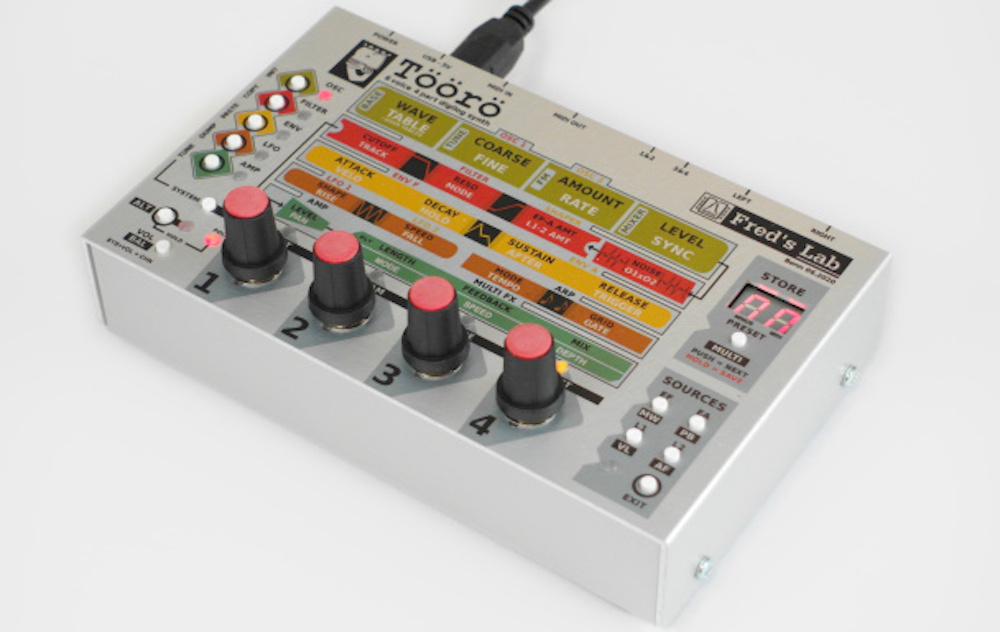Combining wavetables with analogue filters, this clever little synth aims to be the best of both worlds. Greg Scarth finds out what it has to offer.

It’s easy to get caught up in the tired old debate about the relative merits of analogue and digital, but there is a middle ground. The Fred’s Lab Töörö follows this kind of hybrid approach, combining a digital wavetable-based oscillator section with analogue filters. Digital oscillators tend to be cheaper to manufacture and ultimately more versatile than their analogue counterparts, while analogue filters offer unique sonic qualities which are harder to achieve with digital circuits. The hybrid approach – which Fred’s Lab refer to as ‘digilog’ – aims to achieve the best of both worlds.
The Töörö is a compact little unit, supplied with a nice fabric case which hints at its portability. Power is supplied via a USB socket which doubles up as USB MIDI, although the synth can also be triggered over regular 5-pin DIN sockets. The main outputs are in stereo with four additional sub-outputs for individual parts. On the front panel, it’s a simple matter of four main rotary encoders which are used to control all parameters depending on what’s selected. It’s a compromise which helps to keep things compact (and presumably keeps costs down) but it’s reasonably well implemented, with five main ‘modules’ (oscillators, filters, envelopes, LFOs/arpeggiator and amp) selected on the left-hand side to control the main parameters. Additional parameters are accessed via an alt/shift button and a modulation matrix in the bottom right-hand corner. Visual feedback is solely via a two-character seven-segment display but for most parameters it’s sufficient.

Sonically, the Töörö is a joy, justifying the slightly fiddly nature of programming it. The synth excels at slightly retro sounds as you’d expect given the similarities with 80s hybrid classics like the Korg DW-8000 an Ensoniq ESQ1. It’s instant Detroit techno territory a lot of the time, with a certain melancholy edge to the sound which is excellent for pads and wistful leads. There’s a real sweet spot when you dial in an oscillator setting which embraces a slightly fragile digital tone, then beef it up with the lush filter. The Töörö’s analogue low-pass filters are an obvious highlight of the synth and contribute heavily to its character. Based around A847 optocoupler chips, the filters are inspired by that found in the classic Korg MS-10 of the late 1970s, giving a real heft and power to the sound. Once you combine the filters with deeper options such as modulating the oscillators and the ‘shaper’ multi-mode digital filter, you can get a huge range of tones out of the synth.

There are a few clever touches which help to expand the Töörö’s potential. The six-voice polyphony is spread over four ‘parts’, which can also be set up for four-part multitimbrality. As well as being mixed into the main stereo outputs, these four parts have dedicated outputs via two 3.5mm TRS sockets on the back panel. It’s a nice option, allowing you to process each of the sounds separately when playing a multitimbral program, or just treat different parts of a patch separately for some weird effects. Likewise, the modulation matrix, while a little fiddly, offers real power. The multi FX section also proves to be a neat implementation of stereo delay-based effects, allowing you to create sounds like chorus and flanging.

Hybrid polysynths are still fairly uncommon, despite their obvious benefits. There are some big hitters at the top end of the synth market, with the likes of the Waldorf Quantum and UDO Super 6 offering huge sound but with four-figure price tags to match. At more affordable prices, the Arturia MicroFreak combines very interesting digital oscillator options with analogue filters, but its paraphonic design (a single filter for all voices) means that it’s not quite as flexible as the Töörö. As such, there aren’t many obvious rivals out there for the Fred’s Lab offering. It’s a synth which does its own thing and achieves excellent results. If you want something compact, versatile and unique, it’s well worth a look.
Greg Scarth
More info/buy